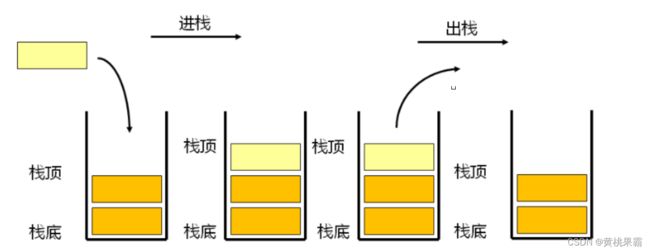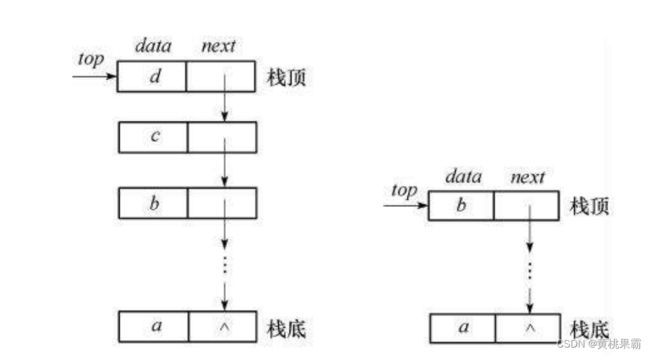数据结构之栈的实现
目录
前言
1.栈的概念
2.栈的实现
2.1 栈的结构
2.2 初始化栈
2.3 入栈操作的实现
2.4 判断栈是否为空
2.5 出栈的实现
2.6 返回栈的长度
2.7 返回栈顶元素
2.8 栈的销毁
3.总体代码测试
总代码
前言
今天给大家介绍一种特殊的数据结构——栈,栈和我们之前介绍的链表和顺序表一样都是线性结构,那栈为什么特殊呢?接下来请大家和小编一起细细了解。
1.栈的概念
概念:栈是一种特殊的线性表,其只允许在固定的一端进行插入和删除元素操作。进行数据插入和删除操作的一端称为栈顶,另一端称为栈底。栈中的数据元素遵守后进先出LIFO(Last In First Out)的原则。
压栈(push):栈的插入操作叫做进栈/压栈/入栈,入数据在栈顶。
出栈(pop):栈的删除操作叫做出栈。出数据也在栈顶。
以上就是栈的演示过程,那么我们如何用代码实现这个结构呢,接下来就让我们继续探讨。
2.栈的实现
2.1 栈的结构
对于栈的实现我们即可以使用链表也可以使用顺序表的形式,但是相对而言数组的结构实现更优一些。因为数组在尾上插入数据的代价比较小。
这里我们可以让数组首元素为栈底,尾部为栈底,top指向下一个我们要插入的元素,具体结构如下
typedef int STdatatype;
typedef struct Stack
{
STdatatype* a;
int top;
int capacity;//表示的是数组容量
}ST;对于栈的链表结构这里大家也可以了解一下
2.2 初始化栈
void STInity(ST* ps)
{
assert(ps);
ps->a = (STdatatype*)malloc(sizeof(STdatatype) * 4);
if (ps->a == NULL)
{
perror("malloc fail");
return;
}
ps->capacity = 4;
ps->top = 0;//top表示的是下一个元素的地址
}对于初始化操作这里是比较简单的,这里我们把初始容量置为4,这里由于是改变结构体内部成员,所以我们的形参只需要一级指针即可。
2.3 入栈操作的实现
void STpush(ST* ps, STdatatype x)
{
assert(ps);
if (ps->capacity == ps->top)
{
STdatatype*temp = (STdatatype*)realloc(ps->a,sizeof(STdatatype) * ps->capacity*4);
if (temp== NULL)
{
perror("realloc fail");
return;
}
ps->a = temp;
ps->capacity = ps->capacity * 4;
}
ps->a[ps->top] = x;
ps->top++;
}对于入栈操作我们需要符合栈的特点,由于我们因为是把数组的尾部当作栈顶的,所以增容时我们只需要让top处的位置处的值为我们需要插入的值即可(添加元素后记得top要加1),还有就是这里我们需要注意当容量不足,我们需要进行增容操作。(由于我们是实现栈,如过进行打印函数进行逐个打印就不符合栈的后进先出的规则,所以我们这里就不好演示,之后总体实现了再给大家看总体效果)。
2.4 判断栈是否为空
bool STEmpty(ST* ps)
{
assert(ps);
return ps->top==0;
}如果栈为空那么top所表示的位置就是0,所以我们只要判断top是否为0即可。相等就返回真,不等就返回假。
2.5 出栈的实现
void STPop(ST* ps)
{
assert(ps);
assert(!STEmpty(ps));//判断栈是否为空
ps->top--;
}由于top表示的是下一个要插入元素的位置,所以在删除的过程中我们仅仅需要将top表示的位置往后移一位即可。
以下实现的功能和逻辑都比较简单我就不详细给大家讲解了:
2.6 返回栈的长度
int STSize(ST* ps)
{
assert(ps);
return ps->top;
}2.7 返回栈顶元素
STdatatype STTop(ST* ps)
{
assert(ps);
return ps->a[ps->top - 1];
}2.8 栈的销毁
void STDestory(ST* ps)
{
assert(ps);
free(ps->a);
ps->a = NULL;
ps->top = 0;
ps->capacity = 0;
}3.总体代码测试
int main()
{
ST s;
STInity(&s);
STpush(&s, 1);
STpush(&s, 2);
printf("%d ", STTop(&s));
STPop(&s);
STpush(&s, 3);
STpush(&s, 4);
printf("%d ", STTop(&s));
STPop(&s);
STpush(&s, 5);
while (!STEmpty(&s))
{
printf("%d ", STTop(&s));
STPop(&s);
}
return 0;
}这里我们实现的操作时先对1,2进行入栈操作,然后打印栈顶元素,出栈顶元素2,然后入栈3,4然后打印栈顶元素,然后出栈4,最后入栈5,最后依次对栈顶元素进行打印出栈的操作,那么这里得到的结果应该是2,4 ,5,3,1.
运行一下,我们看结果
总代码
Stack.h
#include
#include
#include
# include
typedef int STdatatype;
typedef struct Stack
{
STdatatype* a;
int top;
int capacity;
}ST;
void STInity(ST*ps);
void STpush(ST* ps,STdatatype x);
void STDestory(ST* ps);
void STPop(ST* ps);
int STSize(ST* ps);
STdatatype STTop(ST* ps);
bool STEmpty(ST* ps);
Stack.c
#include"Stack.h"
bool STEmpty(ST* ps)
{
assert(ps);
return ps->top==0;
}
void STInity(ST* ps)
{
assert(ps);
ps->a = (STdatatype*)malloc(sizeof(STdatatype) * 4);
if (ps->a == NULL)
{
perror("malloc fail");
return;
}
ps->capacity = 4;
ps->top = 0;//top表示的是下一个元素的地址
}
void STpush(ST* ps, STdatatype x)
{
assert(ps);
if (ps->capacity == ps->top)
{
STdatatype*temp = (STdatatype*)realloc(ps->a,sizeof(STdatatype) * ps->capacity*4);
if (temp== NULL)
{
perror("realloc fail");
return;
}
ps->a = temp;
ps->capacity = ps->capacity * 4;
}
ps->a[ps->top] = x;
ps->top++;
}
void STPop(ST* ps)
{
assert(ps);
assert(!STEmpty(ps));
ps->top--;
}
int STSize(ST* ps)
{
assert(ps);
return ps->top;
}
STdatatype STTop(ST* ps)
{
assert(ps);
return ps->a[ps->top - 1];
}
void STDestory(ST* ps)
{
assert(ps);
free(ps->a);
ps->a = NULL;
ps->top = 0;
ps->capacity = 0;
}text.c
#include"Stack.h"
int main()
{
ST s;
STInity(&s);
STpush(&s, 1);
STpush(&s, 2);
printf("%d ", STTop(&s));
STPop(&s);
STpush(&s, 3);
STpush(&s, 4);
printf("%d ", STTop(&s));
STPop(&s);
STpush(&s, 5);
while (!STEmpty(&s))
{
printf("%d ", STTop(&s));
STPop(&s);
}
return 0;
}


